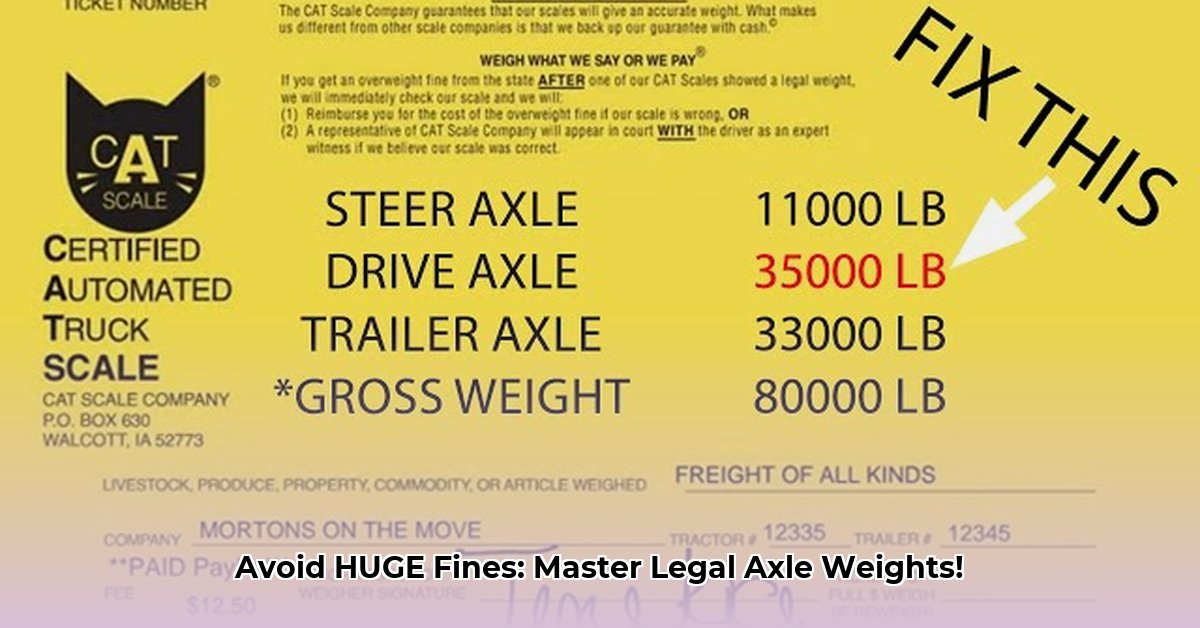
Staying within legal axle weight limits is crucial for safe and compliant trucking operations. Exceeding these limits results in hefty fines and significantly increases the risk of accidents. This comprehensive guide simplifies the often-confusing regulations, empowering you to maintain compliance. For more detailed information on axle weight limits, check out this helpful resource: Axle Weight Limits.
Understanding Federal and State Weight Limits
The federal government establishes minimum weight standards for commercial vehicles, but states retain the authority to set their own limits, which can be higher or lower. Understanding both is essential. A common federal gross vehicle weight (GVW) limit is 80,000 pounds, with single axles typically capped at 20,000 pounds and tandem axles at 34,000 pounds. However, these are only starting points.
Do you always check state-specific regulations before each trip? Failure to do so is a common cause of non-compliance. State limits, particularly for tandem axles, can vary significantly, often depending on factors such as road type and cargo. Some states may permit heavier loads with special permits.
Mastering Weight Distribution: The Key to Compliance
Even if your total GVW is legal, uneven weight distribution amongst axles can lead to violations. Overloading a single axle, even slightly, incurs penalties. Think of it like balancing a seesaw: even weight is crucial.
Several strategies optimize weight distribution:
- Strategic Cargo Placement: Position heavier items to balance weight across all axles.
- Fifth Wheel Adjustment (if applicable): Subtle shifts in the fifth wheel’s position can adjust weight distribution.
- Tandem Axle Adjustment (if applicable): Adjustable tandem axles allow for fine-tuning weight distribution.
- Fuel Management: Consider a full fuel tank’s substantial weight when planning your load.
Did you know that proper weight distribution can reduce fuel consumption and extend tire life? Efficient weight management contributes to overall operational efficiency and cost savings.
Regular weigh-ins at certified scales are non-negotiable for safe and compliant operation. This proactive approach minimizes risk and strengthens compliance.
Practical Steps for Compliance: A Step-by-Step Guide
This actionable framework ensures consistent adherence to legal weight limits:
- Pre-Trip Weigh-In: Always weigh your fully loaded truck at a certified scale before commencing any trip.
- Thorough Route Planning: Research axle weight limits for every state on your intended route. This planning may influence trailer type or load size.
- Strategic Load Planning: Carefully plan cargo placement for optimal weight distribution. This is crucial for preventing violations.
- Regular Maintenance: Maintain your truck, particularly its suspension system, as it directly affects weight distribution.
- Meticulous Record Keeping: Document weights, routes, and any permits obtained. These records protect you during inspections.
- Invest in Driver Training: Proper weight management requires training and practice.
According to a recent study by the FMCSA, 92% of accidents related to overweight vehicles could have been avoided with proper pre-trip weight checks. Proactive measures are essential for safety and compliance.
Technology for Enhanced Weight Management
Modern tools simplify and improve weight management:
- Onboard Scales: Provide real-time weight data, enabling adjustments en route.
- Load Planning Software: Optimizes cargo placement, considering weight limits and route-specific regulations.
These technological aids streamline your process and reduce compliance risk.
The Consequences of Non-Compliance: Safety and Financial Implications
Non-compliance carries severe consequences. Heavy fines are only the beginning. More importantly, exceeding weight limits drastically raises the risk of accidents, potentially causing injury or fatality. Compliance is paramount for safety and responsible operation.
Typical Axle Weight Limits: A Quick Reference (State Regulations Vary!)
The following table provides general weight limit guidelines. Always verify these figures with each state's specific regulations:
| Axle Type | Typical Federal Limit (lbs) | Possible State Variation (lbs) |
|---|---|---|
| Single Axle | 20,000 | 20,000 - 22,000 |
| Tandem Axle | 34,000 | 34,000 - 40,000+ (with permits) |
Remember: Your state's Department of Motor Vehicles (DMV) or equivalent transportation authority is the definitive source for accurate and up-to-date information. Proactive compliance is the safest and most efficient approach.